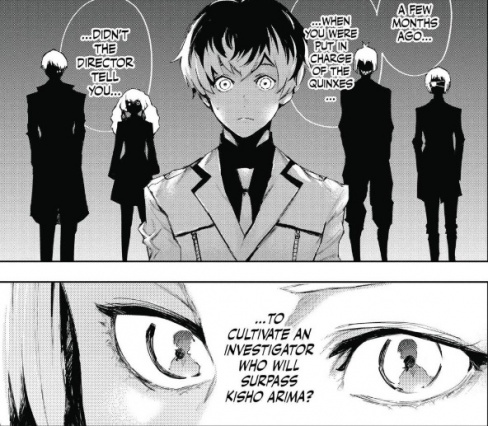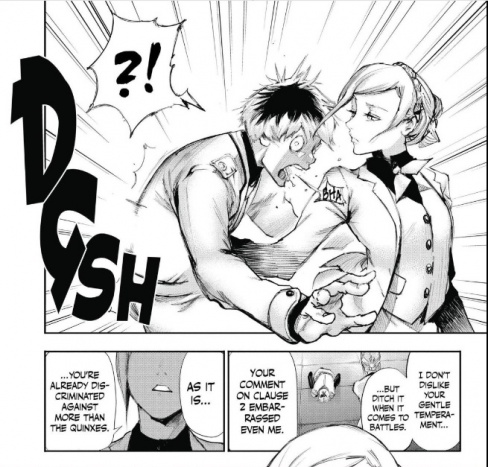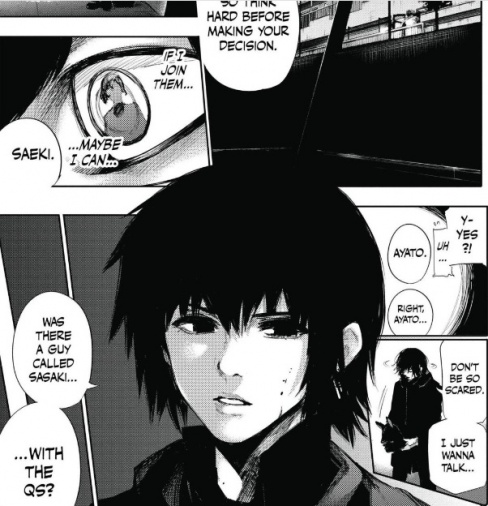With the success of Darcy Forrester’s “Go Beyond” column, we here at Multiversity Comics wanted to expand the more in-depth manga analysis we bring you. It’s not all capes and crimefighters. With that said, welcome to “Ghoul Tidings” (we thought of “Ghoul Beyond,” if only for synergy), a new column where I, the site’s resident Ghoul Liker, take a deeper look into mangaka Sui Ishida’s “Tokyo Ghoul” franchise and explore the world, its characters and its deeper meanings.
Our first column will have us looking at the first volume of “Tokyo Ghoul :re,” the sequel series, which has also just recently launched its anime adaptation. And yes, I have technically reviewed this volume before, but here we’re gonna slow it down and really sink our teeth into the material and digest. Yum!

”Tokyo Ghoul :re” vol. 1 contains Chapters 1-9
“Tell Me, oh Tell Me. Who is that inside of me?” If you followed this series from the anime front, these were the first lyrics to the opening theme, “Unravel.” It’s always been a key to one of the major themes of “Tokyo Ghoul: Identity.” Who are we? Who do we want to be? Who do we become? What are the pieces that make us who we are and what pieces do we share with others?
Identity plays a major part in the Chapter 1 of the series, entitled “Bone.” Here we are introduced to the series protagonist, Sasaki Haise, leader of the CCG (Commission of Counter Ghoul)’s experimental half-ghoul “Qs Squad,” along with those that compose the squad. Ishida uses this time to draw some comparisons to previous series protagonist, Ken Kaneki as well as some contrasts. Both are quite nerdy, but whereas Kaneki was a bit more withdrawn, Haise is more open, in both dealing with peers like Akira Mado and his subordinates. On top of that, he is a bit more playful, like when he’s catty with Akira or when he put on a begging and sympathetic act to get files on a case.
This first chapter gives our introduction to most of the Qs as well, Toru Mutsuki, Kuki Urie, and Ginshi Shirazu. We’re only given brief looks at their personalities here, but I wanted to highlight the visual distinctions Ishida gives them in order to make them immediately distinct. Mutsuki could very well be a clone of early days Kaneki, with a similar haircut and the way he hides his kakugan (a ghoul’s red iris and black sclera when they really draw on their abilities) behind an eye patch. Body language serves more at this point than dialogue to show how green Mutsuki is as he follows Haise. In contrast, Urie shows his own inexperience in the opposite. His expressions are almost deadpan throughout as he goes on the hunt for criminal ghouls, without authorization. While his actions are the contributing factor in taking down a ghoul, it isn’t without collateral damage and -as we see further into the volume- his stoicism is betrayed by underlying frustration at others. Shirazu very much comes off as “comedic relief” in his physical appearance, with his sharp “shark teeth” expressions and his more expressive reactions provide a good balance for Urie moving forward.
Chapter 2, “Reader to Leader,” allows us to slow down after a lot of introductions and take a look at the relationships between these characters, along with some of the underlying “principles” of the CCG. Here, Ishida shows the squad more as a family. It starts with Haise at his apartment, trying to put together his next day. Balancing the meetings he has with the CCG brass, trying to come up with instruction plans for the squad and lamenting on how he’s running out of bookspace. It comes off as positively mundane, but I want to connect this scene with one further down in the chapter: when Haise comes home and cooks dinner for Mutsuki. It’s a small scene, with Haise talking about how Mutsuki has to put meat on his bones, it sells the underlying truth: Haise is the dad figure to these kids who are essentially being used by the CCG. Urie and Shirazu are more antagonistic, but it can be read as two brothers that can’t stand one another. A final part that drives this home actually doesn’t take place in the manga itself, but on the back cover: a drawing by Ishida of the Qs in a playground.
Continued belowThe scenes at CCG headquarters help move the plot forward: with Akira Mado volunteering the squad to hunt down the ghoul serial killer designated “Torso”. It sets the scene for the next few parts of the series, but there was one part here that got to me: the contrast between Haise and the rest of the CCG. The brass are annoyed that the ghoul Urie apprehended wasn’t dealt with immediately, i.e. killed on the spot. Haise explains that under regulations the infliction of unnecessary pain on a ghoul is restricted, to which the higher ups note that doesn’t mean not killing a ghoul. It can easily be interpreted that the CCG are a stand-in for overzealous officers of the law, ultra cynical in comparison to Haise’s more idealistic look. It’s something to consider, especially with the very real issue of police and militarization in real life.

Urie and Shirazu take a more prominent space in Chapter 3, “Bell.” After being contacted by the photographer Chie Hori (herself a character that made her debut in the “Tokyo Ghoul: Days” short story anthology), they are provided an opportunity: information on Torso, in exchange for a personal item of Haise’s. The proposition and how both Urie and Shirazu deal with it further drives a contrast between the two. While Shirazu joined the Qs squad for the money, he still feels uncomfortable lying and stealing from others in the squad. Urie though, is more ambitious and sees the squad more as a means to an end to get himself promoted, further emphasized later when he decides to go at the Torso investigation alone, infuriating Haise.
I would like to take note on the artwork in the later part of this chapter when focus comes back to Haise and Mutsuki. “Tokyo Ghoul” has been known for some gruesome scenes and straight up gore, but Ishida is also capable of hitting comedy, such as Haise’s overly dramatic vows that he and Mutsuki will beat Urie to Torso, combined with Mutsuki’s pure nervousness. However, it is when the two visit Cochlea, CCG’s containment center/prison for ghouls that show Ishida is a master of horror without the gore. The stark, sterile halls of the place sap all the humanity away. But it’s when the two visit Donato Popora, a ghoul that ran a Catholic orphanage in Japan that we see the Silence of the Lambs influence Ishida takes with this Hannibal Lecter-character, introduced with Popora staring directly at the reader. He’s an unsettling man, kept alive for his usefulness. “Not unlike Haise,” a voice whispers in our protagonists head, showing more going inside our investigator than has led on.
It’s on Chapter 4, “Remit to See, Limit to See,” that has the first big return from the previous series: Hinamori Fueguchi. A ghoul girl who was orphaned at the hands of investigators Kuero Mado (Akira’s father) and Kotaro Amon (Akira’s partner before he disappeared in the Anteku raid). A shy, bookish girl who tried her best to deal with the trauma in her life. Here though, we see that she has become a courier for Aogiri Tree, the organization of ghouls that served as the major antagonists in the original “Tokyo Ghoul”’s run. It’s a massive shift from the girl we once knew, but more on this later when another character comes back.
All in all, Chapter 4 is very plot-centric, with the Torso investigation going on and the squad trying to narrow down some form of pattern. It comes off as a bit police procedural in execution, with Haise and Mutsuki interviewing people who knew the victims and Urie and Shirazu going on the information that they were given. Sasaki and Mutsuki do eventually see a pattern, surgical scars. The CCG couldn’t figure it out because “Torso” only kept the… well… torso of his victims. So the two begin to canvas hospitals, but it’s when Mutsuki gets into a cab being driven by Torso that we learn something about Mutsuki.

It is the lead in to Chapter 5, “Resist,” that we learn a bit about Mutsuki’s past: he was taken in by CCG academy after his family was killed by ghouls, a common practice of the organization. But it is in this flashback that we see the one request Mutsuki makes: he doesn’t want to be a girl. He wants to be a guy. Mutsuki is trans. It brings the theme of identity back to the forefront, one’s gender identity being an important aspect of a person. I should make a note: I am not trans. I am very much a cisgendered male, so it is very possible I missed something unintentionally harmful with this reveal. But it does serve to show Mutsuki’s fury as he defends himself against Torso, who keeps misgendering him by calling him “Miss” and even calls him “a little bitch” in thought. Ishida’s action artwork of Mutsuki stabbing at Torso, with a face of desperation, determination and rage on his face is chilling to behold.
Continued belowThis chapter also sees the squad begin to come together as Shirazu and Urie make their chase of Torso’s cab. While the action scene is cool, the two using their kagune (a weapon-like appendage each ghoul can manifest) to try and stop Torso while driving, Ishida also manages a little bit of worldbuilding when Shirazu and Urie’s motorcycle begins to be tailed by the police. Urie makes a hand motion at the cops that signifies they are chasing a suspected ghoul. It doesn’t save the cops from Torso’s kagune, but it’s a little aspect that makes the world feel more real. I have to also give a nod to Shirazu’s kagune, which is kind of like a missile launcher that grows of his back. That’s awesome.
The chase comes to an end as Torso and the Qs are stopped by the arrival of another threat, a masked ghoul criminal codenamed “Orochi”. This moves us into Chapter 6, “Reaction to a Reaction.” It’s not just the snake mask Orochi wears that earned his moniker. The snake tail-like kagune he has shields him from all the attacks that are thrown at him. Ishida also gives a subtle nod to long-time readers and hints at Orochi’s identity when he kicks Urie hard in the face. Speaking of, we get a little insight into Urie when Shirazu says they should retreat. We learn that Urie’s father was the leader of the squad that Urie has ambitions of joining. We see young Urie’s figure learning the squad fail to protect his fathered mirrored in the wounded present-day Urie, who tries desperately to go forward…
…Until Haise makes the save…
Here, Ishida finally gets to show Investigator Sasaki Haise cute loose with his skills with a basic quinque (CCG weapons made from the kagune of killed ghouls). Haise is capable of dashing around, even cutting into Orochi’s kagune and keeping an even footing with Orochi for a time until Haise receives a nice kick to the head… and we get a look into Haise’s mind.
Up until this point, Sasaki Haise has been a kind, affable and idealistic protagonist. However, there is so much going on under the surface. Ishida unleashes some sheer nightmare stuff as we now have a figure to match the voice inside Haise’s mind. A figure that calls him weak and how much he (Haise) needs him. I talked before how identity is a major theme of this series and how we sometimes lie or try to deny who we are and it’s this figure -someone that Haise continuously beats back- that drives home that Sasaki Haise is Ken Kaneki. A Ken Kaneki that could’ve been without the trauma of his mother’s abuse or the tortures he went through under Rize and Jason. Kaneki wants his body back, but Haise won’t give into his fear.

This is the climax of the volume as we go into Chapter 7, “Remind,” where we are given a double-page spread of Haise activating his kagune; the multi-tendriled centipede-like appendage. It’s something eldritch and almost beautiful, as Ishida also uses clever use of negative space to expressive Haise’s sadness, rage and determination to protect his charges. He takes the fight to Orochi, much more confident and driven, almost to the point of madness, which Ishida displays perfectly with Haise’s bloodshot kakugan and devilish grin. It eventually comes to a head when Haise injures Orochi and shatters the mask, revealing it to be another returning character: Nishiki Nishio. Nishiki was one of the first ghouls Kaneki encounter post-transformation and it causes Haise to hesitate just long enough for Nishiki to escape.
Haise recognizing Nishiki (and considering I’m a believer that Nishik has some of the Strongest Hair Game in the series, who wouldn’t?) also causes him to lose control of his kagune, as more CCG backup arrive. It is Akira herself that use RC (Red Child cells. Found in ghouls that produce the kagune) suppressant bullets to essentially “tranquilize” him. It serves as the grim reminder to the entire squad: they’re essentially lab experiments that can be put down if they take a step out of line.
Chapter 8, “Regent,” is the come-down chapter with Urie being reprimanded by Haise for not only going off alone but putting other members of the squad in danger. Urie is being demoted from squad leader, something that Urie is livid at, especially coming from a half-ghoul like Haise. Instead, Haise promotes someone who will put the safety of the whole squad above everything: Shirazu. And the moment Ishida draws is hilarious, with Shirazu so focused on his inner monologue thinking Mutsuki will be the new leader before the news finally dawns on him. Legitimately the most laugh-out-loud moment in the volume.
Continued below
The second half of the chapter is a meeting/sparring session between Haise and his and Akira’s direct superior, the legendary investigator Kishio Arima. It is both of those things, with Arima questioning why Haise promoted Shirazu, but it also has the feeling of a therapist and patient as well -and it’s surprising how direct Ishida is about this- conversation between a father and son. It’s perhaps the most heartfelt conversation in the volume, working on two layers: for those jumping into the franchise with “:re,” it serves to further emphasize the theme of family, but for those who started from the beginning, it has a sinister undertone, considering Arima was there in those last chapters of “Tokyo Ghoul” proper, about to face off against a terrorized Ken Kaneki.
The final Chapter of the volume is called “Recreation” and it’s a fitting name. This chapter sees more subtle (like Akira’s sad looks when talking about losing comrades) and overt returns from the previous series as the squad that was sent to investigate Torso’s home were attacked by an agent Aogiri, the “Black Rabbit” Ayato Kirishima, who is seen here confronting the fugitive Torso. I now have to give credit to something that Ishida did. There is a time skip between “Tokyo Ghoul” and “:re” of about two years and something that bugs me in a time skip is when it doesn’t seem like people changed. The biggest transgressor I think of was in “Naruto” when the time skip happened and the only physical changes that seemed like happened was characters got a little taller. But when it comes to Hinami and Ayato, they look like they have grown as adolescence went on. Ayato’s features are a little sharper and Hinami fuller. Emotionally, we see the scars in their expressions, with Hinami being more serious and Ayato not being the arrogant shit he was. Both serve as stark contrasts to previous encounters.

But now comes more work, with a new case: the “Nutcracker,” named because ghoul in question…well… cracks the nuts of their victims. Yes, I’m talking about testicles. Ishida also introduces another subtle return, mentioning the “Suzuya Squad”, the surname of quirky ghoul investigator Juzo Suzuya. At the end, our Qs stop at a cafe called “:re” (a joke made as to whether it’s pronounced “Ri” or “Rey”) and Haise meets the cafe’s proprietor: Touka Kirishima. Ishida nails this (re)encounter: almost a meet cute with emphasize on the emotions coming out of the eyes. Haise almost in awe at this woman, with Touka expression one of kind courtesy with what seems to be a customer mixed with surprise at this familiar person. It is the moment that long readers of the series would be waiting for in this new -and familiar- work.
Volume one of “Tokyo Ghoul :re” served to create an identity: it wanted to establish characters and just begin to scratch the surface of them. It wanted old readers to feel comfortable and then shake the table a bit. The “Welcome Back” combined with “You Can’t Go Back.” I hope you come with me on this journey in “Ghoul Tidings” as we follow this story, along with some steps of the path along the way.



